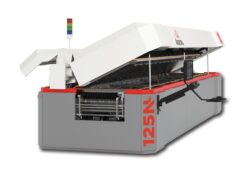The world is facing two major challenges – rising population and climate change – which if no appropriate solutions are found, will result in food shortages. One outstanding response to the challenge is vertical agriculture in the horticultural sector.
With the latest LED technology, which emits very little heat, light sources can be provided close to the cultivated plants without burning them. This enables multi-level cultivation. Compared with conventional farms or standard greenhouses, space and water are used much more efficiently with vertical agriculture, and what’s more it can take place in urban areas.
It also is of interest to high-demand commercial plant cultivation such as cannabis for medical use. The efficiency and reliability of the lighting plays a crucial role in all these fields.
Optimum photosynthesis with the appropriate light spectrum
To optimally promote the plants’ photosynthesis in artificial light the correct combination from a wide wavelength spectrum is required. Only wavelengths of 450nm, 660nm, 730nm and some green light in 520 to 550nm affect photosynthesis. Depending on the phase – whether the plants are at the germination, vegetative or fertilisation stage – a different light composition is ideal. This is particularly the case in a vertical agriculture facility where no natural sunlight is present. Moreover the wavelengths must be adapted to the purpose of the cultivation. This is dependent on whether the plants need to grow quickly or slowly, whether the flowers are the focus or whether particularly large or abundant fruit is required.
When applied individually many colour spectra do not contain a particularly high proportion of photosynthesising light waves. But when combined in the correct proportions with other wavelengths, the rate of photosynthesis goes up. The mixing proportion must relate to the wavelengths found in natural light during the day. For example, as evening draws in, the optimum wavelength is 730nm (far red) to prepare the plants for their night-time rest, while 450nm (deep blue) and 660nm (hyper red) are required for photosynthesis. Different compositions of the light spectrum can be achieved simply by varying the number of LEDs in the relevant wavelengths, without changing the design of the PCB or the luminaries. However, a controller is required to be able to accurately control the LEDs, altering the mix ratio as the day goes on.










